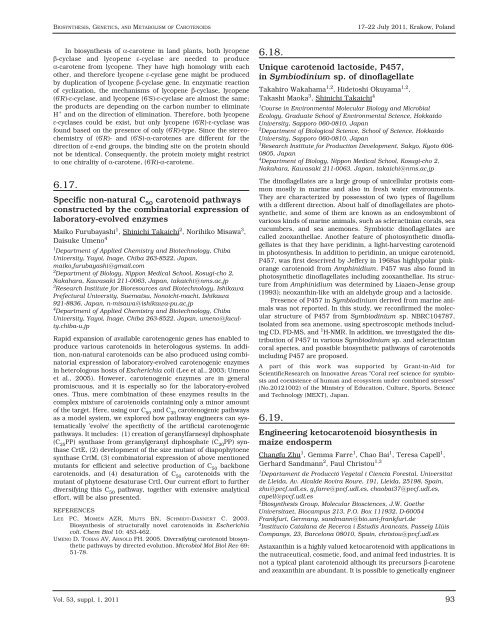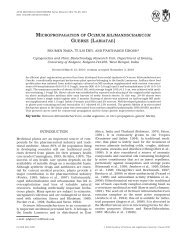ACTA BIOLOGICA CRACOVIENSIA
ACTA BIOLOGICA CRACOVIENSIA
ACTA BIOLOGICA CRACOVIENSIA
You also want an ePaper? Increase the reach of your titles
YUMPU automatically turns print PDFs into web optimized ePapers that Google loves.
BIOSYNTHESIS, GENETICS, AND METABOLISM OF CAROTENOIDS<br />
In biosynthesis of α-carotene in land plants, both lycopene<br />
β-cyclase and lycopene ε-cyclase are needed to produce<br />
α-carotene from lycopene. They have high homology with each<br />
other, and therefore lycopene ε-cyclase gene might be produced<br />
by duplication of lycopene β-cyclase gene. In enzymatic reaction<br />
of cyclization, the mechanisms of lycopene β-cyclase, lycopene<br />
(6'R)-ε-cyclase, and lycopene (6'S)-ε-cyclase are almost the same;<br />
the products are depending on the carbon number to eliminate<br />
H + and on the direction of elimination. Therefore, both lycopene<br />
ε-cyclases could be exist, but only lycopene (6'R)-ε-cyclase was<br />
found based on the presence of only (6'R)-type. Since the stereochemistry<br />
of (6'R)- and (6'S)-α-carotenes are different for the<br />
direction of ε-end groups, the binding site on the protein should<br />
not be identical. Consequently, the protein moiety might restrict<br />
to one chirality of α-carotene, (6'R)-α-carotene.<br />
6.17.<br />
Specific non-natural C50 carotenoid pathways<br />
constructed by the combinatorial expression of<br />
laboratory-evolved enzymes<br />
Maiko Furubayashi 1 , Shinichi Takaichi 2 , Norihiko Misawa 3 ,<br />
Daisuke Umeno 4<br />
1 Department of Applied Chemistry and Biotechnology, Chiba<br />
University, Yayoi, Inage, Chiba 263-8522, Japan,<br />
maiko.furubayashi@gmail.com<br />
2 Department of Biology, Nippon Medical School, Kosugi-cho 2,<br />
Nakahara, Kawasaki 211-0063, Japan, takaichi@nms.ac.jp<br />
3 Research Institute for Bioresources and Biotechnology, Ishikawa<br />
Prefectural University, Suematsu, Nonoichi-machi, Ishikawa<br />
921-8836, Japan, n-misawa@ishikawa-pu.ac.jp<br />
4 Department of Applied Chemistry and Biotechnology, Chiba<br />
University, Yayoi, Inage, Chiba 263-8522, Japan, umeno@faculty.chiba-u.jp<br />
Rapid expansion of available carotenogenic genes has enabled to<br />
produce various carotenoids in heterologous systems. In addition,<br />
non-natural carotenoids can be also produced using combinatorial<br />
expression of laboratory-evolved carotenogenic enzymes<br />
in heterologous hosts of Escherichia coli (Lee et al., 2003; Umeno<br />
et al., 2005). However, carotenogenic enzymes are in general<br />
promiscuous, and it is especially so for the laboratory-evolved<br />
ones. Thus, mere combination of these enzymes results in the<br />
complex mixture of carotenoids containing only a minor amount<br />
of the target. Here, using our C 50 and C 35 carotenogenic pathways<br />
as a model system, we explored how pathway engineers can systematically<br />
'evolve' the specificity of the artificial carotenogenic<br />
pathways. It includes: (1) creation of geranylfarnesyl diphosphate<br />
(C 25 PP) synthase from geranylgeranyl diphosphate (C 20 PP) synthase<br />
CrtE, (2) development of the size mutant of diapophytoene<br />
synthase CrtM, (3) combinatorial expression of above mentioned<br />
mutants for efficient and selective production of C 50 backbone<br />
carotenoids, and (4) desaturation of C 50 carotenoids with the<br />
mutant of phytoene desaturase CrtI. Our current effort to further<br />
diversifying this C 50 pathway, together with extensive analytical<br />
effort, will be also presented.<br />
REFERENCES<br />
LEE PC, MOMEN AZR, MIJTS BN, SCHMIDT-DANNERT C. 2003.<br />
Biosynthesis of structurally novel carotenoids in Escherichia<br />
coli. Chem Biol 10: 453-462.<br />
UMENO D, TOBIAS AV, ARNOLD FH. 2005. Diversifying carotenoid biosynthetic<br />
pathways by directed evolution. Microbiol Mol Biol Rev 69:<br />
51-78.<br />
Vol. 53, suppl. 1, 2011<br />
17–22 July 2011, Krakow, Poland<br />
6.18.<br />
Unique carotenoid lactoside, P457,<br />
in Symbiodinium sp. of dinoflagellate<br />
Takahiro Wakahama1,2 , Hidetoshi Okuyama1,2 ,<br />
Takashi Maoka3 , Shinichi Takaichi4 1Course in Environmental Molecular Biology and Microbial<br />
Ecology, Graduate School of Environmental Science, Hokkaido<br />
University, Sapporo 060-0810, Japan<br />
2Department of Biological Science, School of Science, Hokkaido<br />
University, Sapporo 060-0810, Japan<br />
3Research Institute for Production Development, Sakyo, Kyoto 606-<br />
0805, Japan<br />
4Department of Biology, Nippon Medical School, Kosugi-cho 2,<br />
Nakahara, Kawasaki 211-0063, Japan, takaichi@nms.ac.jp<br />
The dinoflagellates are a large group of unicellular protists common<br />
mostly in marine and also in fresh water environments.<br />
They are characterized by possession of two types of flagellum<br />
with a different direction. About half of dinoflagellates are photosynthetic,<br />
and some of them are known as an endosymbiont of<br />
various kinds of marine animals, such as scleractinian corals, sea<br />
cucumbers, and sea anemones. Symbiotic dinoflagellates are<br />
called zooxanthellae. Another feature of photosynthetic dinoflagellates<br />
is that they have peridinin, a light-harvesting carotenoid<br />
in photosynthesis. In addition to peridinin, an unique carotenoid,<br />
P457, was first descrived by Jeffery in 1968as highlypolar pinkorange<br />
carotenoid from Amphinidium. P457 was also found in<br />
photosynthetic dinoflagellates including zooxanthellae. Its structure<br />
from Amphinidium was determined by Liaaen-Jense group<br />
(1993); neoxanthin-like with an aldehyde group and a lactoside.<br />
Presence of P457 in Symbiodinium derived from marine animals<br />
was not reported. In this study, we reconfirmed the molecular<br />
structure of P457 from Symbiodinium sp. NBRC104787,<br />
isolated from sea anemone, using spectroscopic methods including<br />
CD, FD-MS, and 1H-NMR. In addition, we investigated the distribution<br />
of P457 in various Symbiodinium sp. and scleractinian<br />
coral species, and possible biosynthetic pathways of carotenoids<br />
including P457 are proposed.<br />
A part of this work was supported by Grant-in-Aid for<br />
ScientificResearch on Innovative Areas "Coral reef science for symbiosis<br />
and coexistence of human and ecosystem under combined stresses"<br />
(No.20121002) of the Ministry of Education, Culture, Sports, Science<br />
and Technology (MEXT), Japan.<br />
6.19.<br />
Engineering ketocarotenoid biosynthesis in<br />
maize endosperm<br />
Changfu Zhu1 , Gemma Farre1 , Chao Bai1 , Teresa Capell1 ,<br />
Gerhard Sandmann2 , Paul Christou1,3 1Departament de Producció Vegetal i Ciencia Forestal, Universitat<br />
de Lleida, Av. Alcalde Rovira Roure, 191, Lleida, 25198, Spain,<br />
zhu@pvcf.udl.es, g.farre@pvcf.udl.es, chaobai37@pvcf.udl.es,<br />
capell@pvcf.udl.es<br />
2Biosynthesis Group, Molecular Biosciences, J.W. Goethe<br />
Universitaet, Biocampus 213, P.O. Box 111932, D-60054<br />
Frankfurt, Germany, sandmann@bio.uni-frankfurt.de<br />
3Institucio Catalana de Recerca i Estudis Avancats, Passeig Llúis<br />
Companys, 23, Barcelona 08010, Spain, christou@pvcf.udl.es<br />
Astaxanthin is a highly valued ketocarotenoid with applications in<br />
the nutraceutical, cosmetic, food, and animal feed industries. It is<br />
not a typical plant carotenoid although its precursors β-carotene<br />
and zeaxanthin are abundant. It is possible to genetically engineer<br />
93












